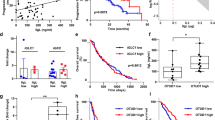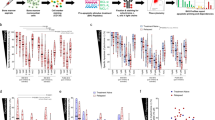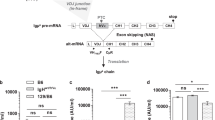Abstract
B cell malignancies are classified according to the postulated differentiation stage of the originating cell. During differentiation, structural and molecular changes occur to support massive processing of immunoglobulin in the endoplasmic reticulum (ER) of plasma cells at the final stage. When overloaded, the ER generates unfolded proteins and hydrogen peroxide (H2O2), which may cause cell death. Peroxiredoxins (Prxs) I and IV belong to a family of proteins able to catalyze peroxide detoxification. Here, we investigated a potential association of these enzymes with immunoglobulin production in B cell neoplasms. Our results demonstrated that the expression of Prx IV was induced as cells became competent to synthesize immunoglobulin light chains, as observed by immunohistochemistry in tissue sections of B cell neoplasms and also by qPCR and Western blotting analyses in malignant B cell lines. Prx I was frequently highly expressed, indicating additional regulatory processes besides ER activity. Results obtained exclusively with myeloma cells have shown that expression of Prxs I and IV, both at mRNA and protein levels, was associated with light chain secretion quantified by ELISA. We suggest that Prxs I and IV may provide survival advantages for terminally differentiated neoplastic B cells by the elimination of H2O2 and, in the case of Prx IV, by the conversion of this toxic in a functional agent driving oxidative protein folding in the ER. In this sense, multiple myeloma and lymphomas demonstrated to synthesize immunoglobulin chains may benefit from strategic therapies targeting the adaptive pathway to ER stress, including inhibition of Prxs I and IV activity.





Similar content being viewed by others
References
Harris NL (2001) Mature B-cell neoplasms: introduction. In: Jaffe ES, Harris NL, Stein H, Vardiman JW (eds) World Health Organization classification of tumors. Pathology and genetics of tumors of the haematopoietic and lymphoid tissues. IARC Press, Lyon, pp 119–126
Shaffer AL, Rosenwald A, Staudt LM (2002) Lymphoid malignancies: the dark side of B-cell differentiation. Nat Rev Immunol 2:920–932
Gross E, Sevier CS, Heldman N, Vitu E, Bentzur M, Kaiser CA, Thorpe C, Fass D (2006) Generating disulfides enzymatically: reaction products and electron acceptors of the endoplasmic reticulum thiol oxidase Ero1p. Proc Natl Acad Sci U S A 103:299–304
Shimizu Y, Hendershot LM (2009) Oxidative folding: cellular strategies for dealing with the resultant equimolar production of reactive oxygen species. Antioxid Redox Signal 11:2317–2331
Kim I, Xu W, Reed JC (2008) Cell death and endoplasmic reticulum stress: disease relevance and therapeutic opportunities. Nat Rev Drug Discov 7:1013–1103
Nakamura M, Gotoh T, Okuno Y, Tatetsu H, Sonoki T, Uneda S, Mori M, Mitsuya H, Hata H (2006) Activation of the endoplasmic reticulum stress pathway is associated with survival of myeloma cells. Leuk Lymphoma 47:531–539
Obeng EA, Carlson LM, Gutman DM, Harrington WJ Jr, Lee KP, Boise LH (2006) Proteasome inhibitors induce a terminal unfolded protein response in multiple myeloma cells. Blood 107:4907–4916
Kang SW, Rhee SG, Chang TS, Jeong W, Choi MH (2005) 2-Cys peroxiredoxin function in intracellular signal transduction: therapeutic implications. Trends Mol Med 11:571–578
Rhee SG, Woo HA (2011) Multiple functions of peroxiredoxins: peroxidases, sensors and regulators of the intracellular messenger H2O2, and protein chaperones. Antioxid Redox Signal 15:781–794
Bertolotti M, Yim SH, Garcia-Manteiga JM, Masciarelli S, Kim YJ, Kang MH, Iuchi Y, Fujii J, Vené R, Rubartelli A, Rhee SG, Sitia R (2010) B- to plasma-cell terminal differentiation entails oxidative stress and profound reshaping of the antioxidant responses. Antioxid Redox Signal 13:1133–1144
Demasi AP, Ceratti D, Furuse C, Cury P, Junqueira JL, Araujo VC (2007) Expression of peroxiredoxin I in plasma cells of oral inflammatory diseases. Eur J Oral Sci 115:334–337
Demasi AP, Magalhães MH, Furuse C, Araújo NS, Junqueira JL, Araújo VC (2008) Peroxiredoxin I is differentially expressed in multiple myelomas and in plasmablastic lymphomas. Oral Dis 14:741–746
Stein H, Delsol G, Pileri S, Said J (2001) Hodgkin Lymphoma. In: Jaffe ES, Harris NL, Stein H, Vardiman JW (eds) World Health Organization classification of tumors. Pathology and genetics of tumors of the haematopoietic and lymphoid tissues. IARC Press, Lyon, pp 237–253
Brunning RD, Borowitz M, Matutes E, Head D, Flandrin G, Swerdlow SH, Bennett JM (2001) Precursor B lymphoblastic leukemia/lymphoblastic lymphoma. In: Jaffe ES, Harris NL, Stein H, Vardiman JW (eds) World Health Organization classification of tumors. Pathology and genetics of tumors of the haematopoietic and lymphoid tissues. IARC Press, Lyon, pp 111–114
Grogan TM, Camp BV, Kyle RA, Müller-Hermelink HK, Harris NL (2001) Plasma cell neoplasms. In: Jaffe ES, Harris NL, Stein H, Vardiman JW (eds) World Health Organization classification of tumors. Pathology and genetics of tumors of the haematopoietic and lymphoid tissues. IARC Press, Lyon, pp 142–151
Greenstein S, Krett NL, Kurosawa Y, Ma C, Chauhan D, Hideshima T, Anderson KC, Rosen ST (2003) Characterization of the MM.1 human multiple myeloma (MM) cell lines: a model system to elucidate the characteristics, behavior, and signaling of steroid-sensitive and -resistant MM cells. Exp Hematol 31:271–282
Marshall-Taylor CE, Cartun RW, Mandich D, DiGiuseppe JA (2002) Immunohistochemical detection of immunoglobulin light chain expression in B-cell non-Hodgkin lymphomas using formalin-fixed, paraffin-embedded tissues and a heat-induced epitope retrieval technique. Appl Immunohistochem Mol Morphol 10:258–262
Tavender TJ, Bulleid NJ (2010) Peroxiredoxin IV protects cells from oxidative stress by removing H2O2 produced during disulphide formation. J Cell Sci 123:2672–2679
Tavender TJ, Springate JJ, Bulleid NJ (2010) Recycling of peroxiredoxin IV provides a novel pathway for disulphide formation in the endoplasmic reticulum. EMBO J 29:4185–4197
Zito E, Melo EP, Yang Y, Wahlander Å, Neubert TA, Ron D (2010) Oxidative protein folding by an endoplasmic reticulum-localized peroxiredoxin. Mol Cell 40:787–797
Balague O, Mozos A, Martinez D, Hernandez L, Colomo L, Mate JL, Teruya-Feldstein J, Lin O, Campo E, Lopez-Guillermo A, Martinez A (2009) Activation of the endoplasmic reticulum stress-associated transcription factor x box-binding protein-1 occurs in a subset of normal germinal-center B cells and in aggressive B-cell lymphomas with prognostic implications. Am J Pathol 174:2337–2346
Reimold AM, Iwakoshi NN, Manis J, Vallabhajosyula P, Szomolanyi-Tsuda E, Gravallese EM, Friend D, Grusby MJ, Alt F, Glimcher LH (2001) Plasma cell differentiation requires the transcription factor Xbp-1. Nature 412:300–307
Shaffer AL, Shapiro-Shelef M, Iwakoshi NN, Lee AH, Qian SB, Zhao H, Yu X, Yang L, Tan BK, Rosenwald A, Hurt EM, Petroulakis E, Sonenberg N, Yewdell JW, Calame K, Glimcher LH, Staudt LM (2004) Xbp1, downstream of Blimp-1, expands the secretory apparatus and other organelles, and increases protein synthesis in plasma cell differentiation. Immunity 21:81–93
Munshi NC, Hideshima T, Carrasco D, Shammas M, Auclair D, Davies F, Mitsiades N, Mitsiades C, Kim RS, Li C, Rajkumar SV, Fonseca R, Bergsagel L, Chauhan D, Anderson KC (2004) Identification of genes modulated in multiple myeloma using genetically identical twin samples. Blood 103:1799–1806
Carrasco DR, Sukhdeo K, Protopopova M, Sinha R, Enos M, Carrasco DE, Zheng M, Mani M, Henderson J, Pinkus GS, Munshi N, Horner J, Ivanova EV, Protopopov A, Anderson KC, Tonon G, DePinho RA (2007) The differentiation and stress response factor Xbp-1 drives multiple myeloma pathogenesis. Cancer Cell 11:349–360
Teng Y, Takahashi Y, Yamada M, Kurosu T, Koyama T, Miura O, Miki T (2007) IRF4 negatively regulates proliferation of germinal center B cell-derived Burkitt’s lymphoma cell lines and induces differentiation toward plasma cells. Eur J Cell Biol 86:581–589
Celada A, McKercher S, Maki RA (1993) Repression of major histocompatibility complex IA expression by glucocorticoids: the glucocorticoid receptor inhibits the DNA binding of the X box DNA binding protein. J Exp Med 177:691–698
Acknowledgments
This work was supported by the Brazilian Agency FAPESP. We thank Jeruza Pinheiro da Silveira Bossonaro, Pollyanna Montaldi, Francesca Ramos da Silva, and Bruno Lima Rodrigues for their excellent technical assistance.
Author information
Authors and Affiliations
Corresponding author
Rights and permissions
About this article
Cite this article
Demasi, A.P.D., Martinez, E.F., Napimoga, M.H. et al. Expression of peroxiredoxins I and IV in multiple myeloma: association with immunoglobulin accumulation. Virchows Arch 463, 47–55 (2013). https://doi.org/10.1007/s00428-013-1433-1
Received:
Revised:
Accepted:
Published:
Issue Date:
DOI: https://doi.org/10.1007/s00428-013-1433-1




